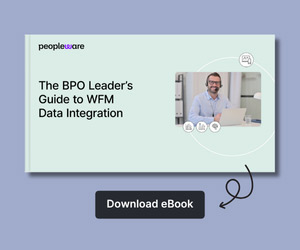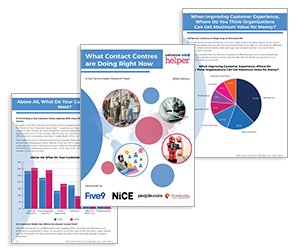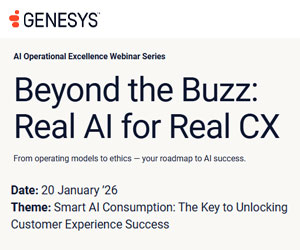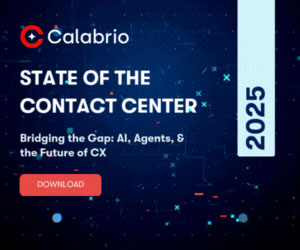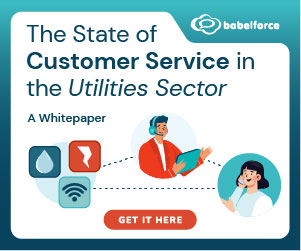Workforce Management (WFM) has always played a vital role in the success of contact centres.
In 2025, its influence continues to grow, not only as a tool for efficiency but also as a strategic asset.
To explore this, we sat down with James Redhead, Head of CX at Peopleware (formerly injixo), to discuss findings from the Peopleware WFM 2025 Benchmarking Report, which draws insights from 38 countries and 14 industries, painting a clear picture of current WFM practices and challenges.
Video: Report Reveals New WFM Findings
Watch the video below to hear James and Xander Freeman discuss the findings of the Peopleware WFM 2025 Benchmarking Report:
With thanks to James Redhead, Head of CX at Peopleware , for contributing to this video.
WFM as a Strategic Tool
One of the most powerful messages from the report is the shifting perception of WFM. It’s no longer seen as a simple operational tool but is now recognised as a strategic asset.
In fact, 99% of respondents said WFM was critical to their business, and 81% reported its importance was growing over time.
“And looking at the feedback that we’ve seen within the report, the benefits of WFM are pretty undeniable. Some of the stats are pretty staggering, I think it was 99% of respondents were saying how WFM is critical to them, personally, but also to their organization and the benefits that it brings.
But equally of those 99%, 81% were saying that they’re seeing that’s increasing over time. So, whilst it’s critical now, they’re seeing that’s becoming more and more critical.
Yeah, there’s I guess external influencing factors cost pressure, drive for efficiency, and all the usual things, and greater competition within the market.
Whatever it may be there’s these different pressures, and we all have pressures all of the time, but people are seeing that as a key challenge, and therefore WFM, always trying to do more with less, helps them to do that.”
With contact centres under constant pressure to deliver more with less, WFM is increasingly relied upon to drive efficiency, manage costs, and support strategic goals.
Key Benefits of WFM: Efficiency, Planning, and Retention
The report highlights three major benefits organisations are seeing from WFM tools:
- Increased operational efficiency
- Reduced planning and scheduling time
- Improved staff retention
“There were three standouts within the responses from the respondents, and some of those are less surprising than others.
Increased efficiency from using a WFM tool, which is one of the things you’d obviously want to see. Reduction in planning time, so the effort that goes into creating the schedules with the forecast, and generating schedules, and obviously day to day operations, that becomes more efficient.
A really key element of the whole thing is reducing turnover of your staff. So how do you improve staff retention?
That obviously has a significant knock-on effect to the organization in terms of your hiring costs, staff engagement, which obviously has an impact on customer satisfaction, customer success. It all wraps up into to being very positive for the organization.”
Reducing employee turnover not only cuts recruitment costs but also improves engagement and customer satisfaction, outcomes that directly affect the bottom line, as James continued:
“And I think one of the things that has surfaced is that WFM is being seen by C suites as increasingly of strategic importance because it drives financial results. But also the impact it has on employee engagement and retention when implemented correctly.
So, it is seen very much as a strategic tool and should be positioned as such, not just a tool for doing a job, it’s important to the organization, and the direction of travel for that organization. So continued investment in WFM, I think is a is a critical thing.”
Hybrid Working and Engagement Challenges
The report also explores the impact of hybrid working, a now permanent feature of many contact centres, as James explained:
“Hybrid working has been around for years, but increasingly has become more and more of a challenge.
And one of the things that’s come out from the report is employee engagement, which can play a part obviously within that hybrid working, giving a level of flexibility, and autonomy to employees to control how they work, where they work, when they work, ultimately, aides the organization.
There are some interesting things that came out in the report. So around 25% of contact centres were saying that they aren’t really fully utilizing demand driven scheduling.
So, if you’ve got a distributed workforce, or hybrid workforce, being able to leverage the benefits of that is key. And therefore, there’s plenty of organizations not leveraging those benefits.”
It reveals that while many businesses support flexible work patterns, around 25% aren’t taking full advantage of demand-driven scheduling.
More concerning is the gap between management and frontline perceptions: while around half of leaders say engagement is a key priority, many employees do not feel empowered or connected to their work:
“Interestingly, where there was quite a big disparity is that around 50 to 53% of organizations are saying employee engagement is critical, it’s an important component.
But actually, well over half of employees, front line employees, were saying they’re not feeling empowered, they’re not feeling that they’ve got that level of engagement.
So, there’s clearly a disconnect between perhaps what organizations or leadership are thinking versus what the frontline workers are feeling.”
Bridging this gap is essential, and it’s not just about technology, as James notes, effective change management and a strong organisational culture are equally vital:
“So, how that gets addressed is a key component of the overall process, and that’s not just technology. Technology is an enabler, and can solve some of those things fairly obviously, but there’s also a change management piece that needs to factor heavily into that.
And that goes obviously from the top all the way down, and bring people on a journey, know, why are we making this change? Why are we going to bring this new tool in? This new process? What does that mean?
And getting buy in at all levels within the organization is important. And if people were bought into a process, and feel connected to that process, and see the benefits of that process, then they’re more likely to come along on that journey and get on board with it, and then you’re going to reap the benefits from doing that.
That’s, I think, a key component of it is to say technology is an enabler, change management should not be overlooked, it’s a significant part of the overall equation.”
Addressing Staffing Imbalances
Only 16% of organisations said they rarely experience over- or under-staffing, which shows that most still face challenges in aligning staff with demand.
“We saw in the survey around 16% of organizations that were saying that they will rarely encounter over or understaffing. That’s a pretty small number.
So, there’s plenty of opportunity out there for the remaining organizations to address those issues of over staffing, understaffing, and flatten that curve and align better to their demand. And when you have a better level of engagement, perhaps with the hybrid workforce, more flexibility for example.
It’s a two way street, it’s a partnership, you’re affording flexibility to the employees, and they’re feeling empowered and engaged, and sort of touching on some of the other items in the report. But that ultimately, it’s full circle, it brings everyone together and drives the right outcomes.”
Better engagement and flexibility, particularly in hybrid teams, can help flatten this curve. But again, it relies on a cultural shift, not just better systems, as James continued:
“I guess it’s pretty easy to say, hey, yeah, we’re going to be employee centric, or we want employee empowerment, engagement.
It’s an easy thing to say, but as you say culture is key, and actually making that happen within the organization is key. You can’t just say it, you’ve got to live it, you’ve got to breathe it.”
Balancing AI and Human Skills
Artificial Intelligence continues to reshape the contact centre industry. However, the report highlights that human skills are still considered more important than technical qualifications, as James explained:
“Obviously AI is a big topic, you can’t really look anywhere without seeing AI. And it is undeniable that it’s going to have a significant impact in many industries, and not least the contact centre industry, or it already is, it’s already there, it’s already prevalent.
What came across from some of the feedback was the leaders and professionals within the WFM industry, and within some of the contact centre industry, were citing that soft skills, human skills, were factored of higher importance than things like formal qualifications, for example.
In fact, I think it was the top three were all in the soft skill arenas, like teamwork, collaboration, empathy, all important things, which they all pair well to a smooth operation, fairly obviously, but also to customer service, and ultimately, that’s what this is about.
So, it’s important for those things to be recognized, and I think AI obviously has its place, it will continue to grow and evolve and find different ways to help the industry and help individuals.
Where there’s an opportunity is for organizations, and moreover individuals, to really embrace that, and not only elevate their technical skills, but also their sort of human centric skills, if you will.
So, you know, being able to embrace technology is one thing, but being able to be strong in all of those soft skills is absolutely critical.”
Qualities such as empathy, teamwork, and communication remain essential for delivering excellent customer service. Emotional intelligence and soft skills will continue to play a major role alongside AI-driven tools.
“AI is not going anywhere, we need to embrace it, but we also need to supplement it, and it supplement the skills that that humans bring to the table.”
If you are looking for more great insights from the experts, check out these next:
- Why You Need to Constantly Monitor and Improve Schedule Efficiency
- Four Steps to Streamline Scheduling
- Tips to Use QA to Fix Broken Processes
- 3 Ways to Reduce Burnout and Keep Agents Engaged
Author: Robyn Coppell
Published On: 16th Jun 2025 - Last modified: 25th Sep 2025
Read more about - Video, Peopleware, Videos, Workforce Management (WFM)




